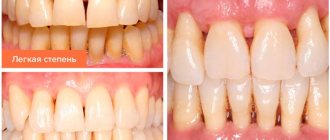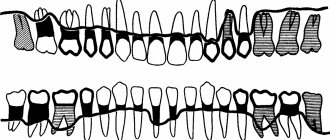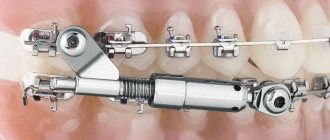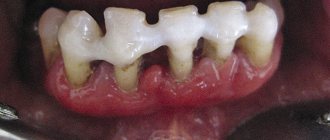Indications
The main indication for installing a clasp denture with a splinting effect is the absence of several teeth in the presence of loose or unstable areas in the jaw structure. The cause of the development of pathologies can be either maxillofacial trauma or degenerative-inflammatory processes in the oral cavity. The second option is the most common. Thus, periodontal damage with receding gums and exposure of the roots leads to loosening of the teeth, while a splinting prosthesis reliably fixes the crowns and does not put pressure on the soft tissues, allowing them to recover. This increases the effectiveness of complex treatment of periodontal disease and periodontitis.
Thus, splinting clasp dentures simultaneously solve several dental problems:
- stabilize mobile teeth in the correct position;
- competently redistribute the chewing load on the gums;
- restore the integrity of the row and the aesthetics of the smile line.
On a note!
Periodontium is a complex of tissues located around the tooth. It includes the gums, alveolar walls, ligaments, and bone tissue. When these structures are destroyed, the tooth root gradually loses support and the tooth begins to wobble.
Contraindications to the installation of splinting clasp dentures:
- Extreme degree of periodontal destruction with a high risk of tooth loss. In this case, it is difficult to take impressions without causing loss.
- The patient’s inability to maintain healthy oral hygiene – when wearing dentures, bacterial plaque accumulates especially actively around the crowns, provoking the carious process.
- Complete absence of teeth (complete edentia) - installation of clasp structures requires the presence of at least one supporting tooth.
- An allergic reaction to anesthesia or materials of construction - metal alloys, plastics, acrylic compounds may cause irritation or discomfort in some patients.
Contraindications
This is what a clasp denture looks like in the mouth.
Splinting clasp dentures have a number of restrictions on installation. They mainly concern the following cases:
- pregnancy period;
- the presence of a negative reaction of the body to metal;
- mental disorders (in particular drug and alcohol addiction);
- cardiovascular diseases;
- during the rehabilitation period after undergoing radiation therapy;
- oncological diseases;
- problems with bone tissue;
- respiratory tract diseases.
Prosthetics are also not performed for dental problems:
- low level of oral hygiene;
- inflammation of the mucous membrane and dental tissues;
- shallow depth of the bottom of the mouth;
- atrophy of the alveolar processes;
- when diagnosing a deep bite, but without the possibility of using another treatment method;
- with pathology of the supporting units or their small height, which makes fixation of the prosthetic structure impossible.
Peculiarities
The German word “byugel” is translated as “arc,” which reflects the main feature of the design: artificial crowns are attached to a curved base made of medical alloy. When put on, the denture fits tightly to the gum due to metal fasteners, which provide reliable fixation without the risk of losing the false jaw. Moreover, in order to remove the prosthesis on your own, you will have to make considerable efforts.
Unlike plate-based removable “brothers”, the prosthesis turns out to be more convenient: the base for the lower jaw is not so massive, and the upper structure is devoid of an inconvenient solid plate that completely covers the palate - it is replaced by a thin bridge that does not create inconvenience during operation. In addition, the clasps and the base itself do not compress the teeth from the sides, which allows complex treatment of periodontal tissues to be carried out without interference.
Types of fastenings for splinting prostheses:
- multi-link clasps (the most common method of fixation);
- occlusal pads;
- claw clamps.
All of them reliably fasten the teeth together, eliminating their mobility, and at the same time contribute to better redistribution of the load along the gingival arch, do not irritate the tissue and prevent gum atrophy.
Features of a splinting clasp denture for the upper and lower jaw
Prosthetics on the upper jaw are performed mainly with clasp dentures. This is due to the following qualities of the product:
- high strength;
- the palatal space does not close completely;
- during the period of adaptation, the gag reflex is not observed;
- the development of prosthetic stomatitis is excluded.
Splinting structures are recommended for restoring dentition in which one or more units are missing. If all teeth are missing, a decision is made to install implants (at least four). Prosthetics with splinting products on the upper jaw are performed in the presence of loose units, their anomalies, as well as for therapeutic purposes in case of periodontal diseases.
Products for the upper jaw are made from openwork casting. The main material for the arc is predominantly a medical alloy. The technique of installing a prosthesis is complex, so it is important that the doctor has the skills and knowledge to perform the job efficiently.
Prosthetics on the lower jaw are carried out faster and easier , therefore all types of clasp dentures are used to restore the dentition. The design is simpler; it lacks the palatal part. The load during chewing is redirected to the supporting teeth, which actually hold the clasp arch.
Stages of prosthetics
At the preparation stage, the patient undergoes an X-ray examination. They evaluate the condition of hard and soft tissues, the structure of the bite, the functioning of the jaw joints, the presence of inflammation, the percentage of destruction of individual structures, and check the general condition of the oral cavity. Immediately before the start of orthopedic treatment, foci of caries are eliminated, professional cleaning is carried out to remove soft and hard deposits in the neck and root area, and curettage is performed if necessary.
Attention!
In the case of high tooth mobility, periodontal pockets are cleaned after the installation of dentures - in order to avoid even further loosening.
The production and installation of splinting clasp dentures takes place in 4 stages:
- Taking impressions – in the classical way using plastic materials or using digital technologies of 3D scanning of the oral cavity. If there is a high degree of tooth mobility, the second option is preferable - it eliminates the possibility of a mobile tooth falling out.
- Creation of a prosthesis - using impressions in a dental laboratory, a copy of the patient’s jaw row is made, on the basis of which the technician forms the base and coronal part of the working structure.
- Fitting and modification - the finished prosthesis is tried on and, if necessary, adjusted, eliminating inconsistencies.
- Final installation is performed by an orthopedic dentist after all roughness of the product has been eliminated.
During operation, the patient can independently remove and install the structure. However, this should not be done unless absolutely necessary - frequent pressure on the tight fastening of the prosthesis can aggravate the mobility of loose crowns. The prosthesis is removed once every 2–3 weeks for preventative cleaning. The rest of the time, hygienic care of the device is carried out directly in the oral cavity with a special brush and paste.
On a note!
In addition to convenient removable structures, there are non-removable medical devices that can be installed and removed only in a dental office. As a rule, they are used for temporary course treatment.
Making a prosthesis
Manufacturing of a splinting clasp prosthesis.
To make an individual prosthesis that would meet all the requirements and perform its functions, you will need to visit the dentist’s office several times. Several stages go through until the finished product is received.
- Initial visit: the doctor examines the patient’s oral cavity to identify pathology, measures the dentition and prepares supporting elements. Based on a visual examination and diagnostic studies, the specialist outlines a treatment plan.
- In a laboratory setting, impressions are taken of the patient's jaws. This work is performed by a dental technician.
- Based on the impressions obtained, the specialist performs computer modeling of the prosthesis, and a model is cast from plaster and wax. The base and frame for artificial teeth are cast in the same way.
- During the first fitting, inconsistencies and other errors made during modeling are identified.
- Based on the fitted model, a clasp prosthesis is made. At the final stage, the product is sanded and polished.
The design production time is about 10 days.
Advantages
Positive aspects of clasp dentures:
- strong fixation – among removable structures they are the most reliable;
- convenient configuration – provide a more uniform distribution of the load on the soft tissue of the gums due to the presence of supporting teeth;
- comfortable to wear - a relatively small base does not cover the palate, does not distort taste, does not impair diction and does not rub soft tissues;
- possibility of installation without grinding healthy teeth;
- long service life - with proper care it can last up to 10 years.
On a note!
A clasp prosthesis, as well as its plate analogue, can lead to gradual atrophy of bone tissue, however, due to optimal redistribution of the load, it develops 2–3 times slower than with any other types of removable structures
.
Fastening methods and photos
Clasp dentures have different types of fastenings. The most popular are the following locking elements.
- Clasps - hook-shaped locks extend from both sides of the base, which are fixed to the supporting units. The chewing load is redirected to the supports. The strength of the structure is ensured by the manufacturing technology; the clasps are cast together with the frame. Products with clasp fastening are considered a budget option due to their relatively low price. The disadvantage of the prosthesis is that with an open smile and an emotional conversation, the hooks become noticeable to others.
Clasps
- Guzikova's paws - a design feature is the presence of an endless clasp located on the lingual surface of loose teeth. Products have also been developed with two endless clasps that extend from the vestibular and lingual sides.
Guzikova's paws
- Telescopic crowns are one of the innovative and complex prosthetic systems. The design consists of two parts: one is attached to a metal plate, the other is placed on support units. They are in close contact with each other. Installation of such a prosthesis requires minor grinding of the supporting teeth. The quality of prosthetics largely depends on the professionalism of the doctor.
Telescopic crowns
- Attachments – the fastening consists of micro-locks that are almost invisible in the mouth. They provide reliable fixation of the structure. The load is redirected to the supporting teeth. In dentistry, different types of attachments are used: rail, spherical, crossbar. The type of fastening on the prosthesis is determined by the orthodontist together with the dental technician.
Attachmen
Rules for caring for artificial teeth
In order for the splinting clasp device to serve for a long time and maintain its aesthetic appearance, it is important to properly care for it. You can minimize the risk of frequent breakdowns if you follow simple rules:
- Clean the device twice a day with a brush and paste that does not contain large abrasive particles;
- rinse your mouth after each meal with warm water or an antibacterial dental rinse;
- clean the system every evening with a special solution;
- Avoid eating too hard foods and never chew on foreign hard objects;
- Visit the dentist twice a year so that he can assess the condition of the prosthesis and correct its location in the oral cavity.
If your denture fails, you should not attempt to repair it yourself. The most reasonable decision in such a situation is to contact your doctor. He will examine the breakdown and, if it can be corrected, will transfer the device to a dental technician. If it turns out that the device needs to be replaced with a new one, he will take care of this issue.






